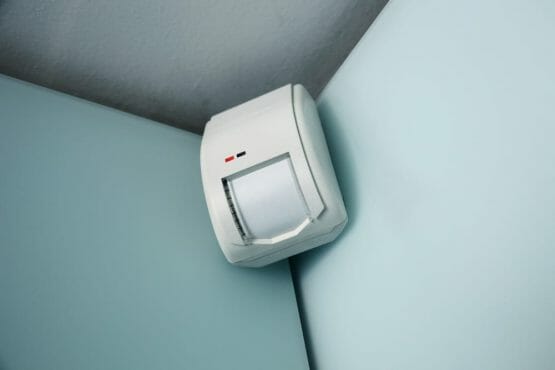Motion sensors can trigger an alarm, open a door or window, send an alert to you via an app, or even trigger an automatic phone call to a security guard. However, there are many motion sensors, so the kind you choose in your home or business may depend on your budget, your use of the motion sensor, and other factors.
I’m here today to tell you a bit about how motion detectors work. Knowing the mechanics behind motion sensors can help you decide which sensor is best.
How Do Motion Detectors Work?
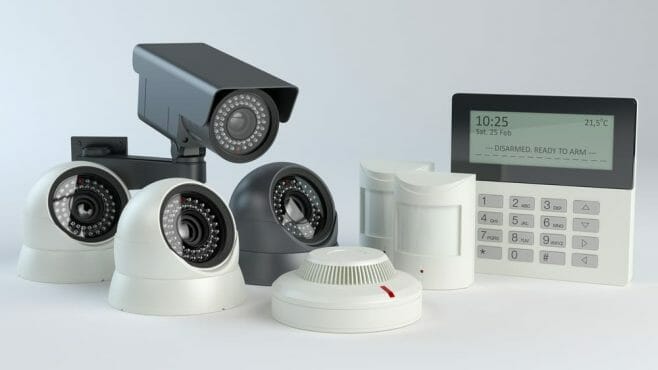
Motion sensors detect a type of energy, a wave, or something measurable in the environment that might change when an object moves. There’s not one type of way that a motion sensor works because different types of motion sensors will measure and are triggered by different things.
#1. Microwave Motion Sensors
Microwave motion detectors send out microwave pulses to bounce off objects in the area around the sensor. The sensor uses microwaves to measure the distance between itself and the other objects in the room. Moving objects create variations in microwave measurements, triggering the alarm.
These devices are more commonly used in commercial settings because they can measure larger spaces than other products on the market. They’re also a little more expensive and exceed many homeowner budgets.
Potential Pitfalls: Microwave detectors can experience interference from electrical pulses. Please read the instructions and manufacturer notes carefully before installation to prevent problems, or have them installed by a professional.
#2. Passive Infrared Motion Sensors (PIR)
Passive infrared motion sensors are the kind of sensors most commonly used in homes and residential settings. PIR devices, and even outdoor PIR motion sensors, measure heat by seeking moving objects giving off more heat than other objects in the background. The object must be moving and in motion, or the PIR won’t detect it, so appliances and other objects that give off heat won’t trip the alarm.
#3. Ultrasonic Motion Sensors
Ultrasonic motion detectors work similarly to microwave sensors. They send ultrasonic pulses that bounce off objects and reflect the sensor. The sensor uses the returning pulse to measure the distance between the objects in the room and the sensor. When measurements change, this triggers an alarm. At one time, ultrasonic motion sensors were popular, particularly when motion sensors were first invented. Today, they’re less common.
#4. Area Reflective Motion Sensors
Area reflective motion detectors are similar to ultrasonic and microwave sensors. Still, reflective sensors use an LED light to emit infrared rays instead of ultrasonic pulses or microwaves. As the rays bounce off objects in the room and return to the sensor, the sensor measures the distance between itself and the objects in the room. When the distance changes, the alarm is tripped.
#5. Vibration Motion Detectors
Vibration motion sensors measure the vibrations in a structure. When the vibrations reach a pre-set threshold, the alarm goes off.
#6. Multi-Technology Motion Sensors
Multi-technology motion sensors are exactly what they sound like: they’re motion sensors that use more than one type of motion detection technology to reduce the chance of a false alarm and accurately measure the presence of a moving object in the room. Usually, multi-technology sensors combine a passive motion sensor (like PIR) with an active motion sensor, like microwave technology.
What Else Do You Need to Know About Motion Sensors?
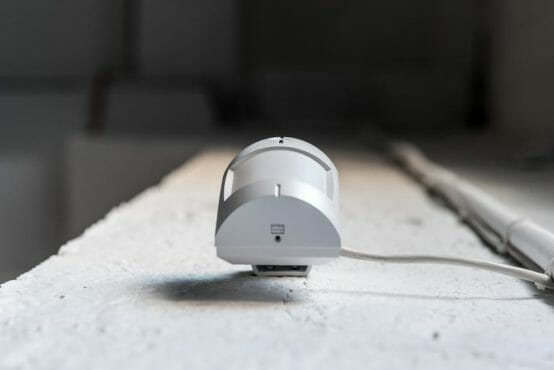
There’s much more to motion detectors than just the basic functionality. Before buying a product, you should understand the limitations of each device and know how to avoid problems like false alarms. Proper installation is important. Plus, if you’re a homeowner with pets, your animal friend’s activities should be considered before making your purchase. Below, I’ve answered some frequently asked questions to help you make an informed decision when purchasing a product. I recommend reading all the questions that apply to you and doing more research before making a purchase.
#1. Do Motion Sensors Have Blind Spots?
A person who understands how a specific type of motion sensor works may be able to fool the sensor. Slow-moving objects, moving objects hidden behind other objects in the room, and moving objects that are short enough to evade detection by the motion sensor may be able to infiltrate the area while avoiding detection.
Solutions:
- Install a multi-technology device. Multi-technology devices were invented to cover all the bases. Installing a multi-technology device makes it more difficult for someone to invade your space without being detected.
- Install multiple devices in one space. The more devices you use in one space, the harder it becomes for someone to invade your home or commercial building. Cover the area thoroughly with sensors, including some out of the way places (like from the ceiling or behind furniture).
- Keep your motion sensors hidden. Some people know how to get past motion sensors. However, people are less likely to avoid tripping motion sensors if they have no idea the sensors are even there.
- Use other devices to protect and secure your home or business. Use a mixture of security cameras, motion lights with alarms, motion-activated infrared cameras, garden motion sensors, smart doorbell technology, window sensors, glass break sensors, and other devices to keep your home or business safe.
#2. How Are Motion Sensors Installed?
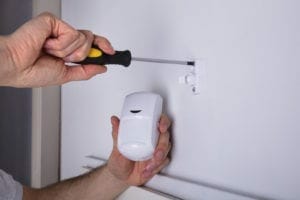
Security companies professionally install some motion detectors. Find out before signing a contract whether installation comes with the subscription or if you’ll be paying a separate charge. If you’re a homeowner, there’s a good chance you’re planning to install your motion sensors. There are a variety of reliable products available on the market. Pick the product that’s right for you. Before making your purchase, do your research. Here’s what you should know before you buy:
- What kind of motion sensor is it?
- Does it get good reviews?
- How long has it been on the market? (Is the product tried and true?)
- Does it fit in your budget?
Once you’ve made a purchase, read the manufacturer’s instructions before setting up the product. Always defer to the manufacturer’s instructions, even if the instructions contradict other advice you’ve read elsewhere. The manufacturer knows best.
Choose the Right Location
Motion sensing technology works best when it’s installed in the correct place.
- Stay about 10-15 feet away from heat registers, sunny windows, hot appliances, and radiators to prevent false alarms.
- Make sure your motion sensor is installed up high whenever possible, but not on top of large pieces of furniture. Most motion sensors can be easily mounted to the wall.
- Motion sensors work best when installed on corners to cover as much square footage as possible.
- Install sensors in locations where people must pass through to enter your home or reach your most valuable possessions.
- Use multiple sensors to cover sensitive areas like entrances and bedrooms in different locations.
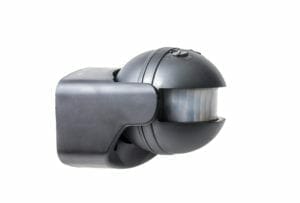
Once you’ve selected the areas of your home where sensors will be installed, please turn them on and test them out with the software that controls the automatic sensors. Most products are now controlled via an app on your mobile device, computer, tablet, or multiple devices simultaneously. Once the app is installed, and the sensors are activated, many systems walk you through the installation process step-by-step. If you’re not especially computer savvy or have bad luck performing these types of installations, choose a product known for being easy to set up.
To ensure good coverage of each room, pair your product with other products like a security camera, break glass sensors, and door entry sensors. Remember that motion sensors can’t detect all problems that could occur with your home. Installing more than one security device on your property will help ensure that you can monitor your home every day, at all times.
#3. Who Needs Motion Detectors?
Motion sensors are for people who:
- Have something to protect or monitor
- Live or work in a high-risk area
- Want peace of mind while away from home or work
You may not think that you’re at risk of a break-in, but if you’ve ever been on vacation and have worried about what was going on at home or in your commercial building, motion detectors may be right for you. You’d be surprised how affordable and easy-to-install motion detectors have become. With the invention of smart technology, people have the ability, more than ever before, to gather data from remote locations and make informed decisions based on the data they collect. Installing motion-sensitive devices on your property allows you to monitor and protect your home or business, even when you’re not there.
#4. What If You Have Pets?
Some motion detectors are designed to ignore pets. Most of the time, these devices measure the height of a moving object and only trip the alarm when a moving object of a certain height enters the monitored space. These devices are not fooled proof, however. For example, if you have a dog who jumps up in excitement when the mailman arrives or maybe a cat who will not stay off the furniture, then false alarms are likely. I recommend installing other devices, maybe some security cameras and break-glass sensors, to monitor your activity at home.
Another fact worth noting is that anyone who crawls into the room at a pet’s height may be ignored, much like a pet. That said, many dogs will not greet strangers who crawl on hands and knees in a polite or friendly way, so depending on the type of pet you own, your bases may be covered anyway.
#5. What Should You Do to Maintain Your Motion Sensor?
Most motion sensors need to be cleaned regularly, or dust can impact their ability to function. Read the manufacturer’s instructions about maintaining your motion sensor, and clean them periodically to remove dust. If your motion sensor stops working at any point, it could be related to dust on the lens or a software problem.
Your sensors likely come with a book that will help you identify common problems, so you can keep your sensors working without getting help from a professional. If you’re not comfortable maintaining your sensors, you might be happier signing a contract with a security company that will maintain the sensors for you. Please find out about their maintenance practices before signing the contract to ensure that you won’t have to pay extra for them to troubleshoot problems or come out to maintain their equipment. The best companies will often stand by their equipment without nickel and diming you for repair.
I’m Here to Help, If You Need It
I’d love your feedback if you enjoyed this explanatory article and found it useful. Tell me what else you’d like to read about in the future. I’m listening!
Motion sensors are useful for homeowners and business owners who want to protect their property using some DIY technology. These devices also help you monitor what’s happening at home or work without being present. They enable you to be in two places at once and act as if something happens in the place being monitored. Whether you live or work someplace that may be at high risk for intruders and burglary, or you want to keep an eye on your pet or children while at home, motion sensors are a tried and true technology, available at an affordable price.
If you have questions, leave your comments in the box below. I’ll be happy to talk!

